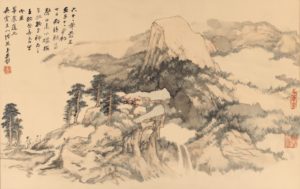Mar 4, 2020
Donated by Family of Yao Ke, Celebrated Writer and Friend of the Artist; Works Date from Chang’s Time in California, Include A Depiction of Yosemite’s Half Dome
Download a PDF copy of this Press Release

March 3, 2020, San Francisco — The Asian Art Museum has been gifted three works created by the renowned ink master Chang Dai-chien (1899–1983) during his sojourn in California in the 1970s. The paintings come from the family of Yao Ke (1905–1991), a longtime friend of the artist and a well-known scholar and writer whose life mirrors the downs and ups of modern China. The bequest to the museum is made possible by the generosity of Yao’s sons, Tony, Robert and John Yao in honor of Professor Hsin-nung Yao (Yao Ke) and Mrs. Dorothy Yao and in memory of Agnes and Hilda Yao.
With this and other recent acquisitions, the Asian Art Museum now possesses the largest museum collection of Chang Dai-chien works outside of Asia, most of which are currently on view in the exhibition Chang Dai-chien: Painting from Heart to Hand (through April 26).
Yao and Chang met in the 1960s in Hong Kong when Yao helped Chang translate his discourse on Chinese painting into English (published 1967). His precise, accessible translation brought Chang’s artistic approach, understanding of Chinese aesthetic values and diverse oeuvre to western audiences and helped solidify his reputation as one of the era’s most important artists working with traditional ink. Yao and Chang remained close friends, sharing a love for Peking opera, and Yao, who moved to the U.S. with his family in 1969, often visited the artist when Chang lived in Pebble Beach, California, from 1971 to 1975.
Prior to his move to the U.S., where he taught at the University of Hawaii, the University of the Pacific in Stockton, California, and San Francisco State University, Yao was already a celebrity in China. He was well known in Shanghai as an esteemed playwright and a young protégé of the famous literary critic Lu Xun (1881–1936), with whom he shared an interest in translating foreign literature. In 1943 Yao married actress Shangguang Yunzhu, one of Shanghai’s biggest movie stars. Their love story was widely covered by the press at the time. Though they later divorced — Yunzhu went on to win favor from Mao Zedong in the 1950s — Yao’s connection with the glamour and cosmopolitanism of pre-Revolutionary Shanghai precipitated his move to Hong Kong in 1949.
“Yao Ke lived an extraordinary life, one that touched on the experiences of many Chinese during the 20th century,” says Jay Xu, Barbara Bass Bakar Director and CEO of the Asian Art Museum. “It is an honor to be able to add masterpieces from Chang Dai-chien that helped trace such a history-making path to our ever-growing collection of significant works of Chinese art.”
The gift to the Asian Art Museum comprises a botanical rendering (Bamboo) and two framed landscapes, Thatched cottages at cloudy mountains and Traveling on remote mountains (all from 1972). In particular, Traveling on remote mountains features a depiction of Half Dome in California’s Yosemite National Park. This painting is currently on display in the museum’s Chang Dai-chien exhibition.
“This is a superlative example of Chang’s work from his California years and it highlights the critical ties between Chinese intellectuals working between the West Coast and Asia,” says exhibition organizer Dr. Fan Jeremy Zhang, Barbara and Gerson Bakar Curator of Chinese Art at the Asian Art Museum. “Chang was the first Chinese artist to creatively employ traditional ink in rendering the natural wonders of California. The graceful integration of an American landmark into a Chinese-style composition showcases how inspired the artist was by the grand landscapes here and the state of intense awe they left in his art — this painting is a treasure with local resonance that will wow our visitors for generations.”
On Mar. 5, from 7–9 p.m., learn more about Chang at this screening featuring excerpts from director Weimin Zhang’s film “Of Color and Ink: Chang Dai-chien After 1949,” introduced by Fan Jeremy Zhang. A conversation between Li Huayi and Arnold Chang, two artists whose work was influenced by Chang’s modernization of ink painting, follows the film screening.
Reception to follow, sponsored by Bonhams Fine Art Auctioneers and Valuers.
Presented in conjunction with Chinese Aesthetics in Northern California — From Chang Dai-chien to Today, a two-day program co-presented by the Asian Art Museum and San Francisco State University, with support from the Mozhai Foundation.
Information: 415.581.3500 or www.asianart.org
Location: 200 Larkin Street, San Francisco, CA 94102
Hours: The museum is open Tuesdays through Sundays from 10 AM to 5 PM. Hours are extended on Thursdays until 9 PM February through September. Closed Mondays, as well as New Year’s Day, Thanksgiving Day and Christmas Day.
Museum Admission: FREE for museum members and children (12 & under). $15 for adults and $10 for seniors (65 & over), youth (13–17) and college students (with ID). Please check website for updates.
Access: The Asian Art Museum is wheelchair accessible. For more information regarding access: 415.581.3598; TDD: 415.861.2035.
Never miss a moment: @AsianArtMuseum
####